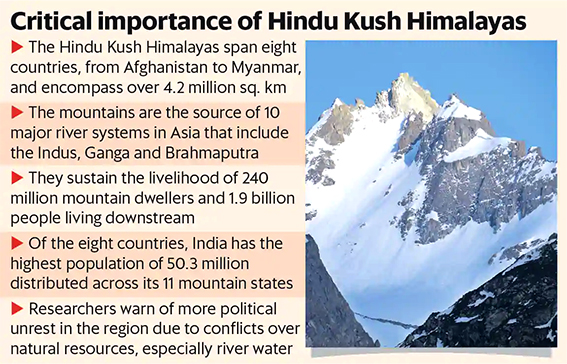-
Q. How will the melting of Himalayan glaciers have a far- reaching impact on the water resources of India? (UPSC GS-1 Mains 2020)
12 Feb, 2021 GS Paper 1 GeographyApproach
- Start the answer by briefly discussing the importance of the Himalayas.
- Discuss the effect of melting Himalayan glaciers on water resources.
- Conclude suitably.
Introduction
The Himalayas is referred to as the Third Pole. Being the major source of water for the rivers, these glaciers are the lifeline for one-third of the population across the globe.
However, the rapid melting of Himalayan glaciers has put enormous pressure on the weather resource of India.
Body
Effect of Melting Himalayan Glaciers
- Frequent Flooding & Droughts: Himalayan glaciers provide for a vital regional lifeline to over two billion people through 10 main rivers that originate from the glaciers.
- Given that there are 8,790 glacial lakes in the region, rapid melting of glaciers could lead to floods from glacial lake outbursts. For example in Uttrakhand flash floods in 2013 and 2021.
- Glacial melt could result in more streamflow due to high glacial melt but for a short time, after which the flow would start reducing and result in conditions of droughts.
- Impacting Moonsoon: The Himalayas exerts a significant influence on seasonal shifts in the monsoon circulation and the distribution of rainfall over India.
- The south-west monsoon accounts for 70% of the annual rainfall in India.
- According to IPCC projections, the melting of glaciers could indicate a likely increase in summer rainfall by 4-12% in the near term and 4-25% in the long term.
- Changing monsoon patterns, including increased severity and frequency of storms, could lead to mountain hazards that may destroy critical infrastructure.
- Destabilize Flow of Indian Rivers: Increasing glacial melts could destabilize Indian rivers by changing their streamflow.
- The Indian rivers like Ganga and the Brahmaputra are partly fed by glacier melt and partly mainly monsoon-fed rivers
- With the impact on monsoon, this will hamper agriculture that accounts for the largest share of water usage.
Conclusion
According to a recent IPCC report the Himalayan glaciers are melting and receding at an alarming rate and if adequate steps are not taken to limit global warming, two-thirds of glaciers in the Hindu Kush Himalayas could melt by 2100.
To get PDF version, Please click on "Print PDF" button.
Print PDF





